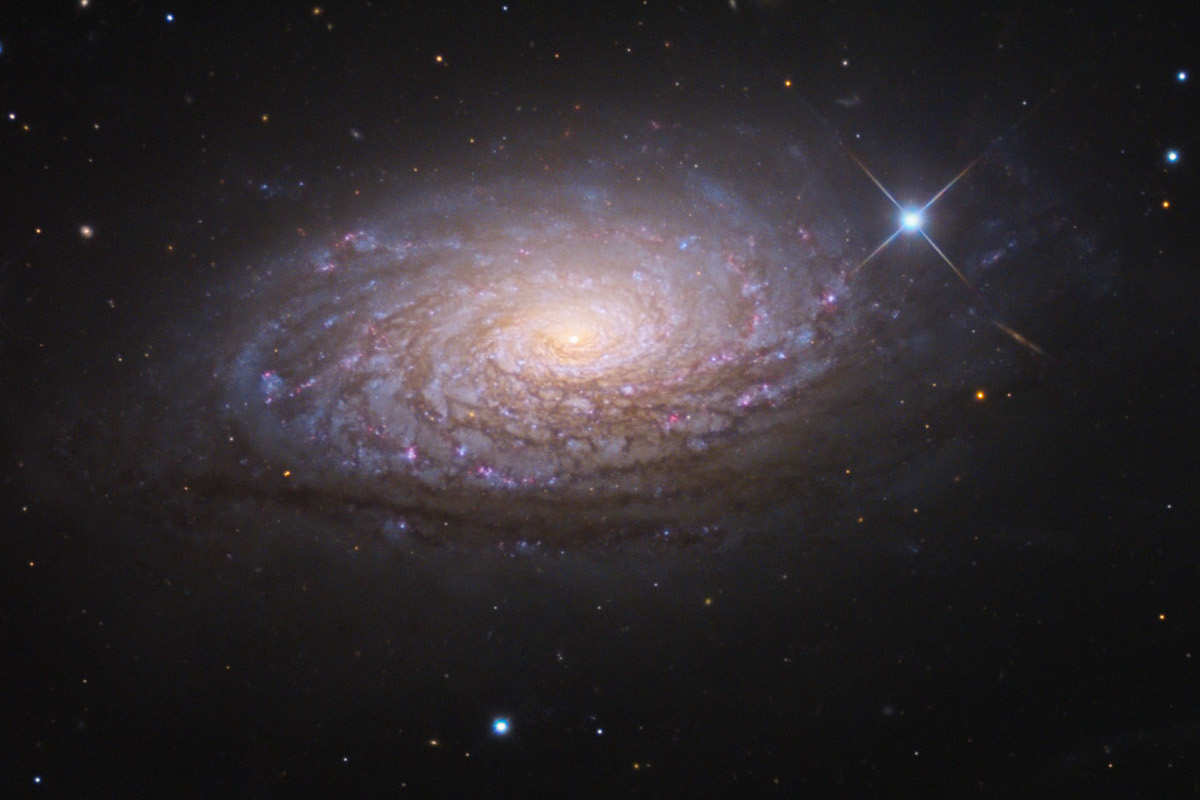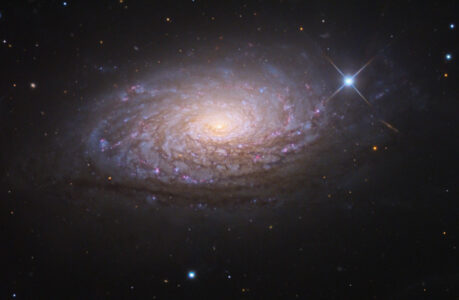Discover the Beauty of the Sunflower Galaxy and How to Observe It!
Are you a stargazing enthusiast, eager to explore the wonders of the cosmos? The night sky offers a myriad of celestial treasures, and one such gem is the Sunflower Galaxy. Also known as Messier 63 (M63), this magnificent spiral galaxy has captured the imagination of astronomers and amateur skywatchers alike. In this beginner’s guide, we will delve into the fascinating realm of the Sunflower Galaxy, providing you with essential information and tips to embark on your cosmic quest.
What is the Sunflower Galaxy?
The Sunflower Galaxy, or M63, is a stunning spiral galaxy located in the constellation Canes Venatici, approximately 37 million light-years away from Earth. Its striking appearance earned it the nickname “Sunflower” due to the distinctive pattern of spiral arms that resemble the petals of the flower. Discovered by Pierre Méchain on June 14, 1779, it was later cataloged by Charles Messier in his astronomical list as the 63rd entry.
M63 boasts an impressive size, spanning about 100,000 light-years in diameter, making it slightly smaller than our very own Milky Way galaxy. This vast expanse contains billions of stars, star clusters, and interstellar dust, creating a captivating canvas for astronomers to study the complexities of galactic structures.
Preparing for the Cosmic Hunt
1. Know the Optimal Time for Observation
The best time to observe the Sunflower Galaxy is during its peak visibility, which occurs in the spring and early summer months in the Northern Hemisphere. During this period, M63 is situated high in the sky, offering a clearer and more unobstructed view. For observers in the Southern Hemisphere, it is visible but appears lower on the horizon.
2. Find a Dark and Clear Sky
To maximize your chances of spotting the Sunflower Galaxy, you’ll need to escape the light pollution of urban areas. Seek out a location with minimal artificial light and a clear, unobstructed view of the night sky. Observing from a dark-sky site will enhance your ability to discern faint celestial objects, like M63, and fully appreciate their splendor.
3. Use Suitable Equipment
While the Sunflower Galaxy can be glimpsed with binoculars, using a telescope will provide a much more detailed and immersive experience. A telescope with an aperture of at least 8 inches (200mm) is recommended to observe the spiral structure and the central bright region of M63. Additionally, using a telescope with good light-gathering capabilities will enable you to view more celestial features within the galaxy.
4. Bring Star Charts and Astronomy Apps
Locating the Sunflower Galaxy requires familiarity with the night sky, and star charts are invaluable tools for finding its position. Bring along a detailed sky map or use astronomy apps on your smartphone, which utilize your device’s GPS to display the real-time positions of stars and galaxies in the sky. Some popular apps include SkySafari, Star Walk, and Stellarium.
5. Patience and Perseverance
Astronomy is an art that demands patience and perseverance. Finding the Sunflower Galaxy might not be an instantaneous feat, especially if you’re a beginner. It’s normal to spend some time scanning the night sky before catching a glimpse of this awe-inspiring cosmic marvel. Stay dedicated and keep your eyes fixed on the heavens!
Unveiling the Sunflower Galaxy
Now that you’re armed with the knowledge and preparedness, it’s time to begin your cosmic quest. Remember, finding the Sunflower Galaxy involves a step-by-step process that starts with identifying the constellation where M63 resides.
1. Locate Canes Venatici
Canes Venatici, often abbreviated as CVn, is a relatively small constellation located near the famous Big Dipper (Ursa Major) and Bootes. Its two main stars, Cor Caroli and Chara, serve as excellent guides to pinpoint the area of the Sunflower Galaxy.
2. Star-Hopping from Cor Caroli
Once you’ve found Cor Caroli, which is the brighter of the two main stars in Canes Venatici, imagine a line connecting Cor Caroli with Arcturus, the brightest star in the Bootes constellation. Then, extend this line about three times its length toward the northeastern direction. There, you should encounter a faint trio of stars forming a small triangle.
3. Identify the Small Triangle of Stars
This triangle of stars acts as a crucial signpost to lead you closer to the Sunflower Galaxy. Focus your telescope on this area, and you’ll notice a faint, elongated smudge of light. Congratulations! You’ve successfully located the majestic M63, the Sunflower Galaxy.
Observing the Sunflower Galaxy
Once you have found the Sunflower Galaxy, take a moment to absorb its celestial beauty. What you see through your telescope is light that has traveled across the vastness of space for millions of years, allowing you to peer into the past and witness the distant marvels of our universe.
1. Discerning the Spiral Arms
The most striking feature of the Sunflower Galaxy is its spiral arms, which extend outward from the bright, central region. With your telescope, try to observe the intricate patterns of these arms as they gracefully wind their way through space. These arms are regions of intense star formation, giving birth to new stars, and they also contain dust and gas that contribute to the galaxy’s ongoing evolution.
2. Spotting the Bright Core
As you observe the Sunflower Galaxy, you’ll notice a bright, compact region at its center. This core is where the majority of stars reside, and its luminosity is the result of the collective glow from millions of stars packed tightly together. Take your time to admire this concentration of stellar brilliance, knowing that it is a bustling hub of galactic activity.
3. Seeking Out H II Regions
H II regions are areas within galaxies where hydrogen gas is ionized by the energy emitted by nearby young, hot stars. The Sunflower Galaxy contains several of these fascinating regions, which appear as glowing patches of gas in your telescope view. The observation of H II regions allows astronomers to study star formation processes and the interplay between stellar winds and interstellar matter.
Capturing the Sunflower Galaxy through Astrophotography
If you’re passionate about both astronomy and photography, astrophotography is a rewarding avenue to explore. Capturing the beauty of the Sunflower Galaxy on camera requires additional equipment and techniques, but the results can be truly breathtaking.
1. Essential Equipment for Astrophotography
To photograph the Sunflower Galaxy, you’ll need the following:
- A DSLR or mirrorless camera with manual settings
- A sturdy tripod to keep your camera steady during long exposures
- A telescope with an equatorial mount for tracking celestial objects
- A T-ring adapter to attach your camera to the telescope
- A remote shutter release or intervalometer to prevent camera shake
2. Long Exposures and Tracking
Astrophotography involves capturing long exposures to gather more light from faint objects like galaxies. Use your telescope’s equatorial mount to track the motion of the stars, compensating for the Earth’s rotation. This tracking will prevent star trailing and ensure that your galaxy images appear sharp and detailed.
3. Image Stacking and Processing
After capturing multiple long-exposure images, you’ll need to stack them using specialized software like DeepSkyStacker or Sequator. Image stacking reduces noise and enhances the signal-to-noise ratio, resulting in a cleaner and more vibrant image of the Sunflower Galaxy. You can further refine your astrophotographs through post-processing using software like Adobe Photoshop or PixInsight.
Conclusion
The universe is a vast playground of wonders, and the Sunflower Galaxy is just one of the many celestial delights awaiting your exploration. Armed with the knowledge and enthusiasm from this beginner’s guide, you’re now equipped to embark on your cosmic journey.
So, head out on a clear, dark night, with your telescope or binoculars in hand, and venture into the enchanting realm of the Sunflower Galaxy. Let the wonders of the cosmos fill you with awe and inspire your love for astronomy. Happy stargazing!

